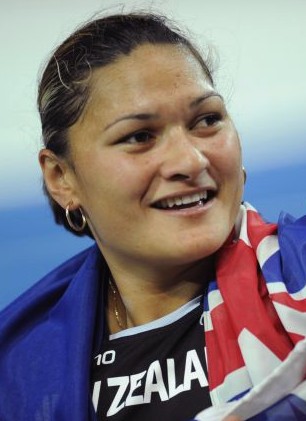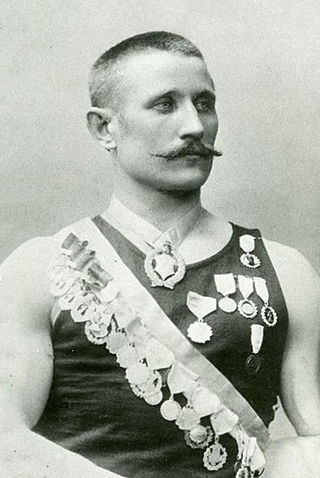
The javelin throw is a track and field event where the javelin, a spear about 2.5 m in length, is thrown as far as possible. The javelin thrower gains momentum by running within a predetermined area. Javelin throwing is an event of both the men's decathlon and the women's heptathlon.
Fred Dagg is a fictional character from New Zealand created and acted on stage, film and television by satirist John Clarke. Clarke appeared on New Zealand TV screens as Dagg during the mid to late 1970s, "taking the piss" out of the post-pioneering Kiwi "blokes" and "blokesses". The sense of the name "Dagg" is associated with the slang term dag. The Fred Dagg character is a stereotypical farmer and New Zealand bloke: clad in a black singlet and gumboots, hailing from the isolated rural town of Taihape, and attended by numerous associates all named "Trev". One memorable expression was uttered whenever there was a knock at the door: "That'll be the door." When Clarke first unveiled the character of Fred Dagg in recordings and on New Zealand TV in 1975, he became a national star. He also recorded a series of records and cassettes as Dagg, as well as publishing several books.

The Wellington boot, often shortened to welly and also known as the gumboot, is a type of waterproof boot.

Track and field is a sport that includes athletic contests based on running, jumping, and throwing skills. The name is derived from where the sport takes place, a running track and a grass field for the throwing and some of the jumping events. Track and field is categorized under the umbrella sport of athletics, which also includes road running, cross country running and racewalking. In British English the term "Athletics" is synonymous with American "Track and Field" and includes all jumping events.

Taihape is in the Rangitikei District of the North Island of New Zealand. It serves a large rural community. State Highway 1, which runs North to South through the centre of the North Island, passes through the town.

The 10th World Championships in Athletics, under the auspices of the International Association of Athletics Federations (IAAF), were held in the Olympic Stadium, Helsinki, Finland, the site of the first IAAF World Championships in 1983. One theme of the 2005 championships was paralympic events, some of which were included as exhibition events. Much of the event was played in extremely heavy rainfall.

Theresa Ione Sanderson is a British former javelin thrower. She appeared in every Summer Olympics from 1976 to 1996, winning the gold medal in the javelin throw at the 1984 Olympics. She was the second track and field athlete to compete at six Olympics, and the first Black British woman to win an Olympic gold medal.

Fatima Whitbread, is a British retired javelin thrower. She broke the world record with a throw of 77.44 m in the qualifying round of the 1986 European Athletics Championships in Stuttgart, and became the first British athlete to set a world record in a throwing event. Whitbread went on to win the European title that year, and took the gold medal at the 1987 World Championships. She is also a two-time Olympic medallist, winning bronze at the 1984 Summer Olympics and silver at the 1988 Summer Olympics. She won the same medals, respectively, in the Commonwealth Games of 1982 and 1986.

Dame Valerie Kasanita Adams is a retired New Zealand shot putter. She is a four-time World champion, four-time World Indoor champion, two-time Olympic, three-time Commonwealth Games champion and twice IAAF Continental Cup winner. She has a personal best throw of 21.24 metres (69.7 ft) outdoors and 20.98 metres (68.8 ft) indoors. These marks are Oceanian, Commonwealth and New Zealand national records. She also holds the Oceanian junior record (18.93 m) and the Oceanian youth record (17.54 m), as well as the World Championships record, World Indoor Championships record and Commonwealth Games record.
Keg-tossing is a sport that involves the heaving of a standard 15.5 gallon beer keg. Most people would refer to this type of keg as a "half-keg" or "half-barrel." The keg must be completely emptied before it should be tossed to avoid injuries. There are many different types of keg-tossing, as it is practiced throughout the world. In Ireland, the keg is typically thrown over upwards and the height of the toss determines the winner.

Venne "Verner" Järvinen was a Finnish track and field athlete, who competed mostly in throwing events. He won the gold medal in the Greek-style discus in the 1906 Intercalated Games, and the bronze in the 1908 Summer Olympics, becoming the first Finnish Olympic medalist in athletics. He won the Finnish championship in Greek style discus three times in 1909–1911 and held the national record in discus and hammer throw.

Egg tossing or egg throwing is a game associated with Easter. Various types of such games exist, common ones involve throwing an egg so that it lands on the ground without breaking. Such a contest may be known as an egg toss.
These are the official results of the Women’s javelin throw event at the 1994 European Championships in Helsinki, Finland, held at Helsinki Olympic Stadium on 11 and 12 August 1994. There were a total number of 22 participating athletes. All results were made with a rough surfaced javelin. The qualification mark was set at 61.00 metres (200.13 ft).

Hunter Boot Limited is a British footwear manufacturer that is known for its rubber Wellington boots. Originally established in 1856 as the North British Rubber Company, the firm is headquartered in Edinburgh, Scotland. It also has offices in London, New York and Düsseldorf. In addition to rubber boots and other footwear, Hunter sells products such as bags, socks and accessories. It previously made tyres, conveyor belts, combs, golf balls, hot water bottles and rubber flooring. Hunter holds several Royal Warrants as suppliers of waterproof footwear. Green Wellington boots, now manufactured in China, are its best known product.
Shoe-tossing is the throwing of footwear, the reasons for which differ based on cultural context.

Finnish skittles, also known as Karelian skittles, outdoor skittles or kyykkä, is a centuries-old game of Karelian origin. The aim in Finnish skittles is to throw wooden skittle bats at skittles, trying to remove them from the play square using as few throws as possible. Skittles can be played with four-person teams, in pairs or as an individual game. Finnish skittles is one of the three skittles games played in the World Championships of Gorodki Sport. The other games include Classic Gorodki and Euro Gorodki.
Abdul Buhari is a British athlete who competes in the discus throw. He was born in Nigeria.

The New Zealand Athletics Championships is an annual outdoor track and field competition organised by Athletics New Zealand, which serves as the national championship for the sport in New Zealand. It usually takes place over a three-day period from Friday to Sunday. Typically organised in the Southern Hemisphere summer months of February or March, the competition was inaugurated in 1887 as a men-only event, with women's events being added to the programme from 1926 onwards.

The Fergus Scottish Festival and Highland Games is a three-day cultural festival that has been held in the town of Fergus, Ontario, for more than 70 years. The festival includes events leading to the World's Scottish Athletic Championship. It is the oldest festival of its kind in North America.















